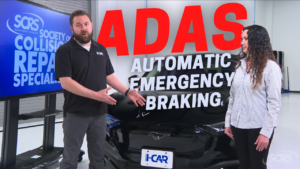
SCRS consumer videos feature I-CAR, provide customer-focused education on ADAS
By onEducation | Repair Operations | Technology
The Society of Collision Repair Specialists (SCRS) Consumer Tips YouTube series now includes a new iteration of videos to educate consumers on the functions and repair considerations of vehicles equipped with advanced driver assistance systems (ADAS).
The safety systems automatically alert and/or intervene in certain driving situations to avoid collisions or lessen impact including those that could involve pedestrians, bicyclists, and motorcyclists. Examples of the systems are automatic emergency braking (AEB), reverse AEB, lane keeping assistance, forward collision warning, lane departure warning, and blind spot warning.
So far, the series covers AEB, blind spot warning, and surround view cameras. The videos feature a collaboration with I-CAR ADAS and electric vehicle (EV) instructors.
In the video on AEB, Kurt Fenzel, I-CAR ADAS and electric vehicle instructor, provides an overview of the systems that work together for AEB to function and where they’re located. He also shares how certain types of collision damage can cause AEB to fail to operate as designed or to be inoperable.
“We’re always going to be concerned about what’s behind the bumper. Now that we know that we have a radar module back there, any type of impact we’re going to want to remove the bumper and inspect that radar module make sure the bracket isn’t bent make sure it’s still level and again, if that bumper is being removed and put back on, most OEM service information is going to tell you that radar module is going to have
to be calibrated.”
SCRS Chair Amber Alley added that repairers should also always check paint manufacturer information for correct paint color and mil thickness because a lot of colors could cause the bumper to not be repairable. This can be because the metallic flake in the paint or the color doesn’t allow the radar or lidar to read the road ahead, she said.
Another important fact for repair shop customers to be made aware of is ADAS contributes to higher repair costs because of the parts and components involved, needed calibrations, and more labor hours.
A study released by AAA in December found that ADAS including AEB, blind spot monitoring, iand lane departure warning – can increase repair costs by up to 37.6% after a collision.
“Even minor damage to systems such as front radar or distance sensors can result in additional repair expenses up to $1,540,” a AAA press release states.
The increase comes from the cost of replacing and calibrating sensors, it said.
A January survey held by AAA found that consumer interest in semi-autonomous technologies such as reverse AEB and lane keeping assistance remains high.
Nearly two-thirds of respondents said they want reverse AEB (65%), AEB (63%), or lane keeping assistance (62%) on their next vehicle. For interest to remain high, it’s crucial to ensure consistency in the performance and naming of the systems, AAA said.
In July 2022, AAA, Consumer Reports, J.D. Power, National Safety Council, PAVE, and SAE International released a set of expanded and updated recommendations for universal terms for ADAS features. The SCRS videos use those standard terms to describe the functions and systems being addressed.
All of the videos, as well as Consumer Tip, Quick Tip, and Repairer Driven Education videos, can be found at youtube.com/@SCRSCollision.
Images
Featured image: I-CAR’s Kurt Fenzel and SCRS Chair Amber Alley discuss how AEB works and where its components are located. (YouTube screenshot)
